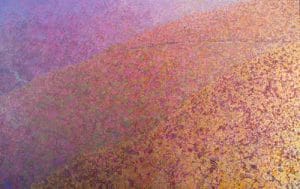Following his discharge from the army at the end of WWII, Wigley joined the 1949 AP Elkins anthropological expedition into central Australia as the official artist. It was from that expedition that he developed an empathy for Australian aboriginals and their life.
After travelling and studying in Europe he returned to Australia and eventually settled in Port Headland in1957 where he formed a friendship with Don McLeod the aboriginal activist. It was then that Wigley commenced recording aboriginal life which was to become the theme for much of his future work.

This painting depicts a traditional aspect of that life. It is the time of the day just before the sun appears over the horizon and is often referred to as Piccaninny Dawn. It’s the time when an experienced aboriginal hunter carrying little more than his traditional hunting implements and a sack over his shoulder chooses to set out on a journey to find a quarry that will provide for himself and other members of his group. He and his dogs appear tiny in the vast landscape which gives the impression of being desolate and unyielding and one wonders how the hunter could succeed in a place so bleak.
The title of the work appears to be a misnomer as the land gives no hint to the inexperienced that is has supported traditional aboriginal life for many thousands of years and if left in its traditional state would continue to provide.
This is a social realist work and was painted in Port Headland a few years before the area would undergo extensive mining that would yield a different kind of bounty. Wigley was to record that change to the region and the displacement of the traditional owners in a masterful work The Arrival of the Machines – The Hunter gives no insight of what is about to occur in the immediate future.
The Hunter is an important work from Wigley’s oeuvre and was included in the exhibition of Australian Landscape Painting 1837-1964 that was held at The National Gallery of Victoria in 1964.








